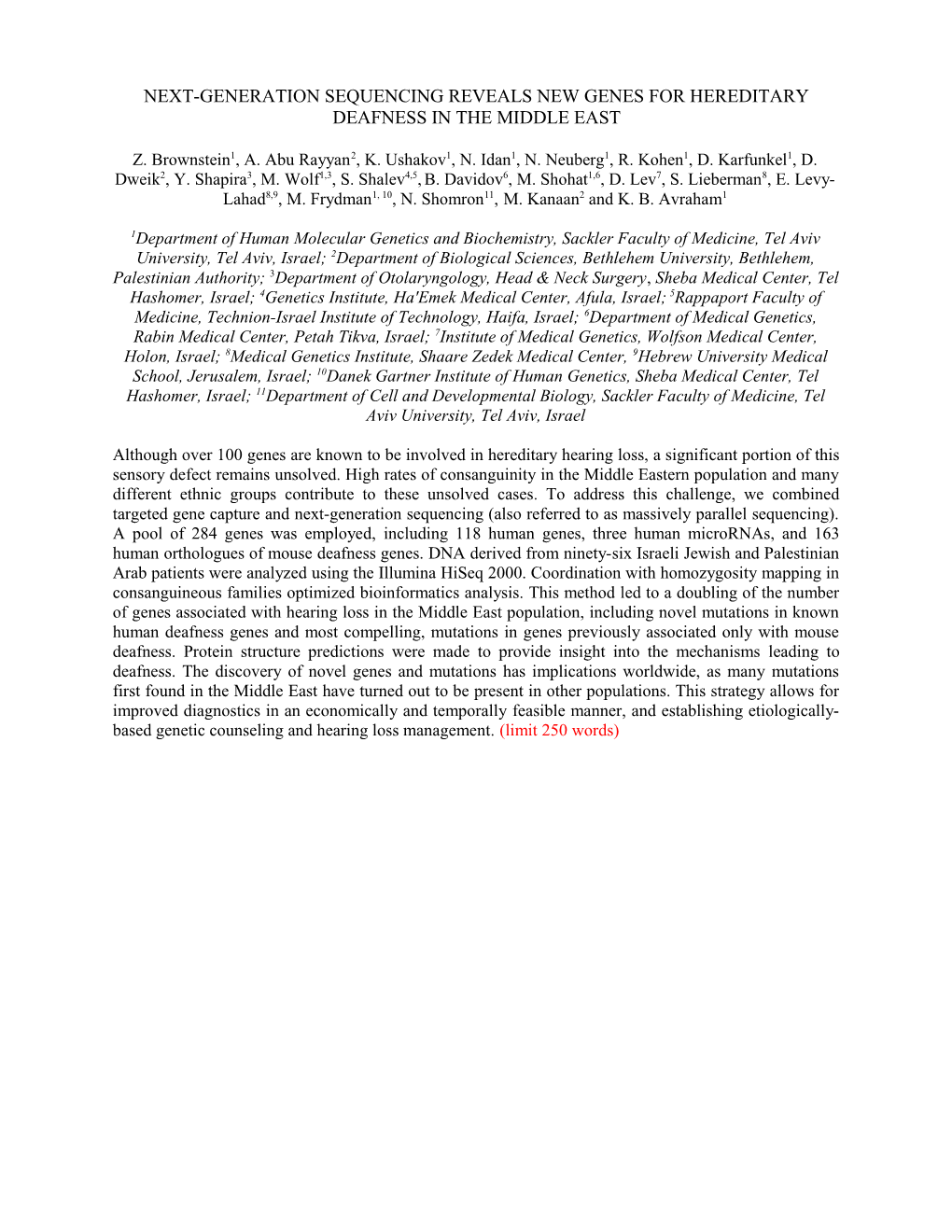NEXT-GENERATION SEQUENCING REVEALS NEW GENES FOR HEREDITARY DEAFNESS IN THE MIDDLE EAST
Z. Brownstein1, A. Abu Rayyan2, K. Ushakov1, N. Idan1, N. Neuberg1, R. Kohen1, D. Karfunkel1, D. Dweik2, Y. Shapira3, M. Wolf1,3, S. Shalev4,5,B. Davidov6, M. Shohat1,6, D. Lev7, S. Lieberman8, E. Levy-Lahad8,9, M. Frydman1, 10, N. Shomron11, M. Kanaan2 and K. B. Avraham1
1Department of Human Molecular Genetics and Biochemistry, Sackler Faculty of Medicine, Tel Aviv University, Tel Aviv, Israel; 2Department of Biological Sciences, Bethlehem University, Bethlehem, Palestinian Authority; 3Department of Otolaryngology, Head & Neck Surgery, Sheba Medical Center, Tel Hashomer, Israel; 4Genetics Institute, Ha'Emek Medical Center, Afula, Israel; 5Rappaport Faculty of Medicine, Technion-Israel Institute of Technology, Haifa, Israel; 6Department of Medical Genetics, Rabin Medical Center, Petah Tikva, Israel;7Institute of Medical Genetics, Wolfson Medical Center, Holon, Israel;8Medical Genetics Institute, ShaareZedek Medical Center, 9Hebrew University Medical School, Jerusalem, Israel; 10Danek Gartner Institute of Human Genetics, Sheba Medical Center, Tel Hashomer, Israel; 11Department of Cell and Developmental Biology, Sackler Faculty of Medicine, Tel Aviv University, Tel Aviv, Israel
Although over 100 genes are known to be involved in hereditary hearing loss, a significant portion of this sensory defect remains unsolved. High rates of consanguinity in the Middle Eastern population and many different ethnic groups contribute to these unsolved cases. To address this challenge, we combined targeted gene capture and next-generation sequencing(also referred to as massively parallel sequencing). A pool of 284 genes was employed, including 118 human genes, three human microRNAs, and 163 human orthologues of mouse deafness genes. DNA derived from ninety-six Israeli Jewish and Palestinian Arab patients were analyzed using the IlluminaHiSeq 2000. Coordination with homozygosity mapping in consanguineous families optimized bioinformatics analysis. This method led to a doubling of the number of genes associated with hearing loss in the Middle East population, including novel mutations in known human deafness genes and most compelling, mutations in genes previously associated only with mouse deafness. Protein structure predictions were made to provide insight into the mechanisms leading to deafness. The discovery of novel genes and mutationshas implications worldwide, as many mutations first found in the Middle East have turned out to be present in other populations. This strategy allows for improved diagnostics in an economically and temporally feasible manner, and establishing etiologically-based genetic counseling and hearing loss management. (limit 250 words)
